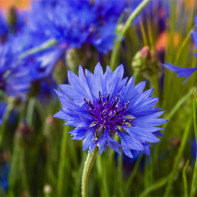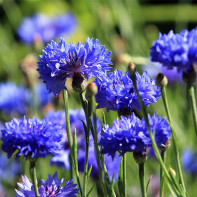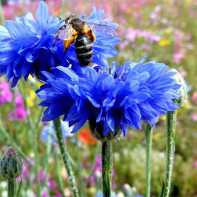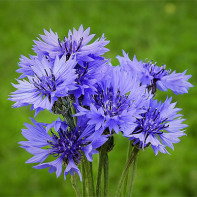Cornflower: medicinal properties and contraindications
It is difficult to imagine a summer field without a scattering of beautiful, blue flowers. They are called cornflowers. There are quite a few species growing in our country. Almost any such interesting flower will look great in a bouquet. However, the cornflower blue or field is also used in medicine and cooking.
- Chemical composition
- How it looks and where it grows
- Types
- Gathering and storage
- Cornflower medicinal properties
- Cornflower in folk medicine
- For colds
- For hypertension
- For vision
- In nephritis, inflammation in the ureter
- Urinary stones
- For the urogenital system
- For liver and gallbladder problems.
- For the bowel
- Conjunctivitis
- Types of medicinal compositions
- Infusion
- Tincture
- Decoction
- Tea
- Oil
- Cosmetic Applications
- Face Lotion
- For facial pore control
- For problem skin
- Hair Strengthening
- Cooking Usage
- Sauce
- Salad
- Vegetable side dish
- Borsch
- Contraindications for use
Marginal petals have been used in canning products since ancient times. Traditional Russian pickles can't do without field cornflower. Flowers, leaves or stems are added to various seasonings, especially to meat dishes. They impart a subtle aroma of cloves, mint and lemon, not pronounced enough, but easily caught.
In medicine, the marginal petals of the flower itself, without the basket, are used. They are dried and prescribed for colds as a laxative and choleretic. They alleviate nephritis and urethritis.
Chemical Composition
The marginal funnel-shaped petals go into the harvest. The best raw material is bright blue in color. The baskets do not carry any useful properties and come into the box only as a weed component. The standards allow 1% of substandard components - flower baskets, leaves, closed buds, earth, pebbles.
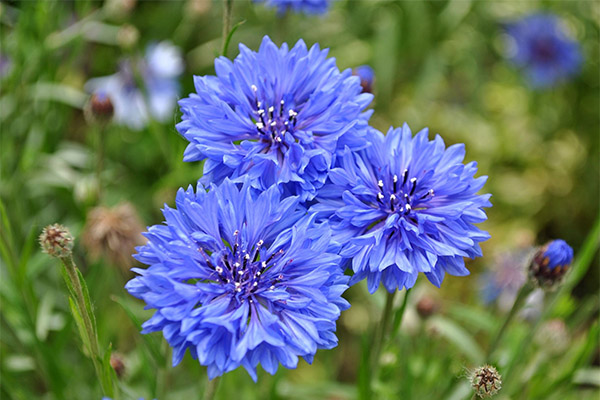
The composition stands out only for blue cornflower petals, they contain:
- tannins;
- the active glycosides cetaurin and cicorin;
- the coloring glycoside cyanine;
- caffeic, quinic and chlorogenic acids;
- essential oils;
- vitamins A and C;
- trace elements: copper, selenium, zinc.
Centaurin, cicorin and cyanine are the most valuable for medical use. They are responsible for the main medicinal possibilities of cornflower. By the way, it has been found that flavonoids and glycosides are most abundant in flowers that have grown in fields with oats.
What it looks like and where it grows
Cornflower is easily identified in the field by its rich blue flower. It is an annual plant, with a slender stem. Height rarely exceeds 70 cm, the usual size for the field cornflower is 30-50 cm. The leaves are ternate, weakly expressed, dying off by the time of flowering.
The flower has a formed basket with blue petals around it. The outer leaves are medicinally valued; they have a unique five-toothed shape. The window of active flowering is June-July.
Blue cornflower grows throughout Russia and Europe, except in the Far North and arid regions. The plant prefers sandy soils. It can be found in any field of rye, oats or flax. It also grows well in meadows and fallow fields.
Species
More than 500 species of cornflower are registered, of which 184 grow in Russia. Most of them are of little medical or culinary value. Farmers control the flower as a weed in the fields. Ruminants can eat it without any consequences.
Among the widespread species in Russia, the ragwort and meadow cornflower should be singled out - they are excellent honeydrops, and are used in folk medicine to a limited extent. The most valuable is the blue or field cornflower. It is used in cooking, honeysuckle for the winter, and is included in various medical gatherings.
Other cornflower species are often used for decorative purposes and may be of limited use as honeydrops or as fodder for ruminants.
Gathering and storage
Only the bright blue petals of the cornflower are used for medicinal purposes. They are plucked from funnel-shaped flowers that are in the active flowering stage. The best time is June-July, rarely early August. After that the petals' content of useful substances goes down. Cornflower seeds are also prized by the culinary industry and are harvested closer to mid-August.
There are several harvesting techniques. The ancient one is more gentle for the plant. Hands pick only the outermost, most beautiful and brightest blue leaves. The flower itself is not damaged. The new industrial technology prescribes to pluck or cut flower baskets and then extract blue petals from them, while white corollas are thrown away. Raw material collected by this technique is sold in pharmacies as cornflower gatherings and teas.
The plucked petals are dried at 40-50 degrees. Useful glycosides may begin to break down when exposed to prolonged dry heat. Nowadays, artificial dryers are commonly used. But you can also use the old tried-and-true method, spreading the raw material out in a thin layer on paper in a well ventilated room.
Dried cornflowers can be stored for up to a year. However, it is necessary to keep the raw material in a dark place, because sunlight will lead to the decay of cyanine and other active substances. This can be determined visually - spoiled dried petals turn white.
Therapeutic properties of cornflower
- Decoctions and infusions on cornflower flowers have a pronounced choleretic and antispasmodic effect. They improve the function of the gastrointestinal tract, have a mild laxative effect. Noted diuretic and stimulating effect on the kidneys.
- Located in the composition brevicepsin dilates blood vessels and normalizes slightly elevated blood pressure. By relieving spasm of smooth muscles marked moderate analgesic effect.
- Anti-inflammatory and disinfectant capabilities of cornflower blue are actively used by doctors and folk healers. They use lotions, dressings, and compresses on wounds, inflammations, bruises, or ulcers. Allowed to be included in the complex therapy to combat conjunctivitis and blepharitis as an alternative to other symptomatic drugs.
Cornflower in folk medicine
Healers have included cornflower blossoms in a variety of potions and healing gatherings since ancient times.
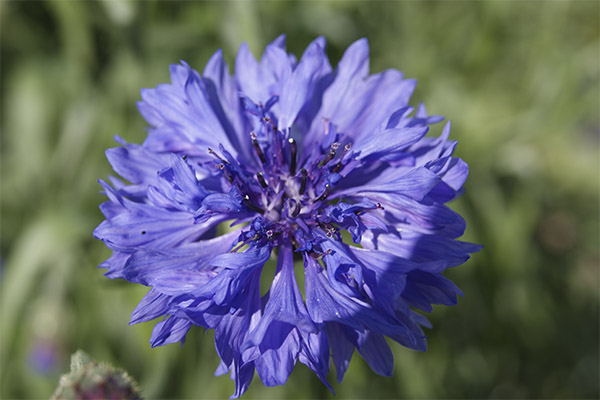
For colds.
A good vitamin composition, strong active ingredients can accelerate the recovery from the flu, colds, bronchitis and significantly alleviate the overall condition. It is recommended to take the following components:
- cornflower dry - 20 g;
- Honey - 15 g;
- Water - 250 ml.
Pour 250 ml of boiling water over the dry remedy. Leave to infuse for 30-40 minutes. Strain, put a spoonful of honey and drink the entire liquid 20 minutes before a meal. This will give strength to the body to fight the disease, will ease the course of the illness.
In hypertension
When hypertension is most effective herbal collection, which includes the following components:
- yarrow dried - 10 g;
- valerian root - 15 g;
- white mistletoe - 10 g;
- mountain ash berries - 20 g;
- Cornflower dried flowers - 15 g;
- Hawthorn fruits - 10 g.
The mixture of herbs and fruits should be ground and mixed, you can use a blender. Pour the finished collection into a container, and then take 1 tablespoon per glass of boiling water. Insist for 20-30 minutes, before using, strain. A glass is enough for 3 intakes, 70-80 ml, immediately after a meal.
For vision
This collection will help improve vision with myopia. You will need:
- incised aloe leaves - 20 g;
- Eyebright herb - 50 g;
- Cornflower flowers - 50 g;
- honey - 600 g;
- red wine - 500 ml.
Fresh aloe leaves should release excessive juice, so you need to cut them and leave for 15-20 minutes. The herb Euphrasia, cornflower flowers and aloe leaves washed of excess juice put in a blender or coffee grinder, grind until homogeneous. Now you need to construct a water bath, in a bowl put honey, red wine and medicinal herbs. Steam for about 50 minutes, maintaining a temperature of 60-70 degrees. After filtering, you can start taking. The optimal dosage is 1 tablespoon three times a day.
With nephritis, inflammation in the ureter
It is necessary to prepare such a phytotherapeutic preparation:
- bearberry leaves - 15 g;
- Juniper twigs - 20 g;
- Cornflower petals - 15 g.
Mix the ingredients into a single mass and scoop out 1 dessert spoon with a small slide. In this way, you can get the necessary proportions at the rate of 250 ml of liquid. Infuse the composition for 15 minutes, pouring steep boiling water. Filter, using a sieve or folded gauze. Take three times a day, 1 tablespoon.
When urolithiasis
Get rid of urolithiasis will help the following medicinal collection:
- Blue cornflower flowers - 15 g;
- nettle fresh - 10 g;
- walnut leaf - 15 g;
- calendula - 15 g;
- veronica dry - 15 g;
- Tricolor violet - 25 g.
Raw materials must be thoroughly mixed. Pour 1000 ml of hot water, but not boiling water. Leave to cool for 5-6 hours. Strengthen the infusion can be simply by wrapping the container in towels or a blanket. Then place the container on the stove and keep on the verge of boiling. Ten minutes is enough. Drink every 4 hours, but no more than 5 times a day, 1 tablespoon.
For the urogenital system
Various problems with urination will delicately solve the infusion made according to this recipe:
- lingonberry leaf - 1 tablespoon;
- Cornflower flowers of the field - 1 tablespoon;
- Boiling water - 500 ml.
The herbs should be poured steep boiling water and insist under a lid. Forty minutes is enough, but you can wait a little longer, it will increase the concentration and effect. After straining, take small portions of 50-70 ml. The entire infusion should be consumed in one day. Positive effect is felt after the third reception. The therapeutic course - no more than a week.
When there are problems with the liver and gallbladder
The following tincture is used:
- flowers of blue cornflower - 20 g;
- good vodka - 300 ml.
Dry plant should be placed in a container with vodka and shaken thoroughly. Insist in a dark, slightly cool place. Critically important to protect cornflower from direct sunlight. After 10 days you can take the drug. The optimal dosage is 30 drops before meals, three times a day.
For the intestines
Various problems with intestinal peristalsis and chronic constipation can be treated using cornflower. To do this, you will need:
- dried flowers - 25 g;
- Boiling water - 250 ml.
Dry cornflower should be poured boiling water, stirred and covered tightly. Insist up to two hours. Then use only before eating 30 ml. If mild action and correction is needed, it is enough to take the infusion twice a day. Increasing the number of intakes with the same dosage will increase the laxative effect.
When conjunctivitis.
Quickly cure conjunctivitis will help the following collection:
- rosehip flowers - 10 g;
- chamomile - 10 g;
- Plantain leaves - 10 g;
- Cornflower flowers - 10 g.
All herbs should be mixed and pour 250 ml of steep boiling water. Insist under a tight lid for up to half an hour. Filter the cooled infusion, using absorbent cotton or gauze, and then drip 2 drops daily. Store the preparation in the refrigerator, but it is important that the substance be at room temperature before dripping.
Types of healing compositions
Field cornflower combines well with an aqueous, alcoholic and fatty base. It is included in various herbal gatherings, where it enhances their healing effect. The active substances are released in water temperatures above 50 degrees. Boiling is well tolerated, losing only some vitamins and a small part of the glycosides.
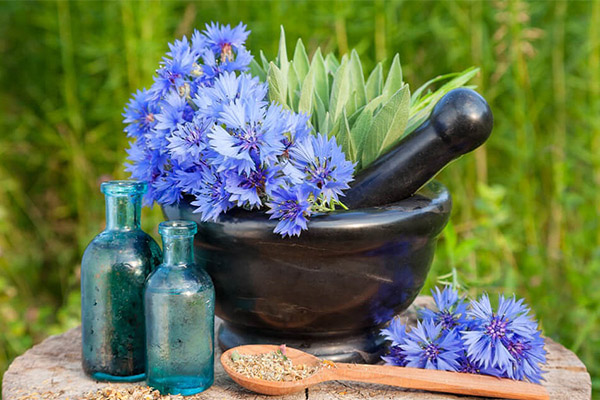
Infusion
The aqueous base effectively retains the active substances from cornflower flowers. Concentration distinguishes between infusions for external and internal use. A classic potion that strengthens the body, helping to beat a cold faster, includes:
- dried flowers of cornflower blue - 3 teaspoons;
- Boiling water - 1 liter.
Pour the medicinal herb with steep boiling water. Stir thoroughly and cover the container. The optimal period of infusion - 30 minutes. When adding other herbs or berries may require more time to give useful substances in the water.
Infusion for external use has a different concentration:
- cornflower field - 1 tablespoon;
- Boiling water - 250 ml.
It is prepared similarly, except for the infusion time, up to one hour. It is desirable to wrap the container in a towel or cloth to keep the high temperature longer.
Tincture
The alcohol-based form will require up to two weeks of time, but then the tincture can be stored for a year, it will remain effective and healing. For preparation will be required:
- dried cornflower flowers - 50 g;
- good vodka - 500 ml.
The optimal ratio of the base and therapeutic agent - 10 to 1. Place the cornflower flowers in a bottle with vodka and shake. But it is better to use a darkened container. Under sunlight, these petals lose their useful properties. Insist in a dark, cool place for at least two weeks. Store for a year.
Decoction
The traditional decoction is especially effective in the treatment of bronchitis, angina, it is used as an expectorant. It is also used in the form of drops and lotions to get rid of blepharitis and conjunctivitis. The preparation involves:
- marginal petals of cornflower - 1 teaspoon;
- water - 250 ml;
- honey - 30 gr.
Dry petals add to water and bring to a boil on the fire. Boil for 2-3 minutes. Boil a more concentrated preparation for external use for 5 minutes. Then remove from the fire and leave at room temperature for an hour. The cooled decoction, which is intended as an expectorant or to combat angina, should be flavored with honey.
Tea
This is the simplest and most accessible form of cornflower application. In pharmacies, you can find collections already packed in bags, they should be brewed as an ordinary tea. Self-cooking will require the following ingredients:
- Dried cornflower flowers - 2 teaspoons;
- green tea - 1 teaspoon with a handful;
- boiling water - 500 ml.
In a container to put tea and cornflower flowers, and then pour boiling water. With the lid closed, brewing will take 5 minutes. Before serving, add a spoonful of honey or sugar for a better taste.
Oil
Oil is not used for medicinal purposes, only in cosmetology. It smoothes the skin, especially in the eye area, infuses it with useful substances, prolongs youth, improves the tone of the subcutaneous layers. To prepare the classic recipe you will need:
- dried petals of field cornflower - 1 tablespoon;
- olive oil - 60 ml;
- Vitamin E - 3 drops.
You need to grind dry petals of cornflower in a mortar or blender. Then gradually pour the olive oil, stirring the mixture, and finally add a few drops of vitamin E. It can be applied at once in the form of a mask or face compresses.
Cosmetic applications
Many facial care products and various cosmetics contain an extract of blue cornflower flowers. It can be found in tonics, gels, makeup remover, shampoos, and conditioners. It is prized by commercial companies for its versatility and affordability.
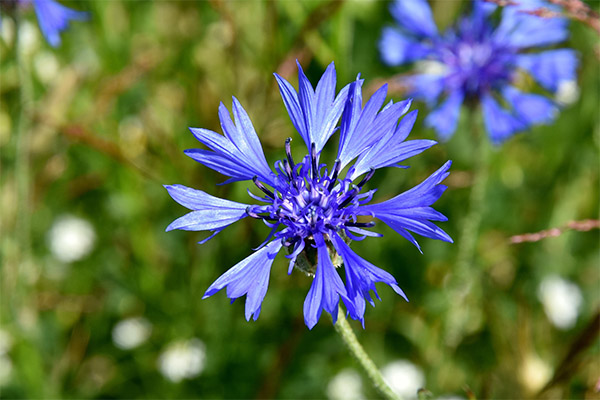
The active ingredients in cornflower have a pronounced anti-inflammatory effect. They heal wounds, help get rid of acne and pimples on the face or body. It is especially useful to use cornflower for people with oily skin. Even a small addition to the composition allows you to cleanse and then narrow the pores, even out the subcutaneous structure. A matting effect is created, it remains for quite a long time.
The use of cornflower petals in care products visually improves hair health. When rubbed, the roots are strengthened, the skin is better cleansed and saturated with useful substances, which is the prevention of dandruff. An increase in hair growth rate has been noted with the addition of cornflower extracts to the daily shampoo.
Face Lotion
It is possible to use cornflower at home, the recipes are quite simple and the ingredients are available and inexpensive. Creating a versatile facial lotion involves:
- dried flowers of cornflower - 30 g;
- lemon juice - 1 tablespoon;
- hot green tea - 400 ml.
It is optimal to use tea brewed for 5-7 minutes. Add cornflower blossoms to it, close the container until it cools naturally to body temperature. Before the procedure, pour lemon juice into the lotion and stir. For oily skin you can add alcohol, regular vodka - 100 ml.
For tightening pores on the face
It is easy to prepare the simplest decoction to narrow the pores on the face. To do this, you will need:
- Field cornflower flowers - 2 teaspoons;
- Water - 500 ml.
Add the herb to water, cover and boil for 10 minutes. Then let cool to room temperature and strain. Apply it with a tampon or use an old face pack, dampening the inside of it.
For problem skin
People with problem skin prone to inflammation should use this infusion:
- succession dry - 10 g;
- chamomile - 10 g;
- calendula - 10 g;
- cornflower - 10 g;
- boiling water - 200 ml.
Mix all the ingredients and pour hot water, insist a day at the same temperature. The best way to do this is to use a thermos. However, you can wrap any container, slightly warming it 2-3 times a day. Apply it better as a mask, to do this, take 1 tablespoon of the resulting infusion and add it to a viscous mixture of olive oil and honey. The optimal exposure time - 20 minutes.
Strengthening hair
Hair is also useful cornflower. For an effective means to strengthen the roots will be required:
- Cornflower flowers - 1 tablespoon;
- vinegar 9% - 250 ml;
- water - 250 ml.
Vinegar, water and medicinal plant should be mixed, and then leave to insist at room temperature. The remedy will be ready in half an hour, and you can store it in the refrigerator for up to two weeks. To strengthen the roots, you need to rub the infusion 2 times a day, and before going to bed, be sure to rinse your head with plain water.
Use in cooking
In addition to the pronounced medicinal properties, cornflower has found wide application in the traditional kitchen. The flowers and seeds of the plant are used, dried and crushed. The spice in powder form can rarely be seen in supermarkets, cornflower is often included in various mixes for pickles, soups or meat.
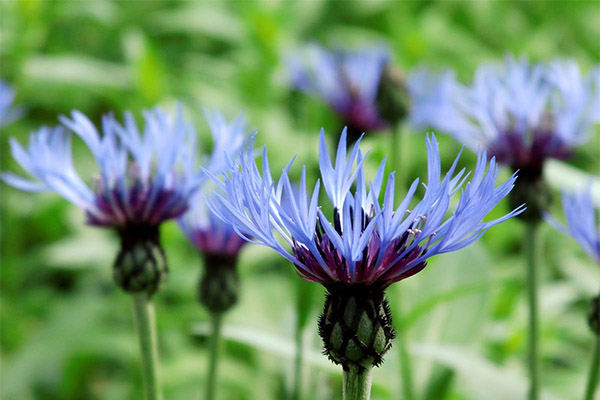
Preparations can be well diversified with petals and cornflower seed powder. They give a subtle minty-lemon flavor and improve the preservation of pickles. The recipe is extremely simple, you should add 10-15 grams of powder and 2 teaspoons of petals for a three-liter jar of canned vegetables.
Cornflower leaves have a subtle but distinct flavor, something between lemon, mint and cloves. The seeds are a bit like red chili peppers, but with a slight minty flavor. This combination would go well with a versatile sauce for rice, mashed potatoes and meat dishes.
Sauce
The following products are needed for the preparation:
- beef or chicken broth - 2 tablespoons;
- Grated tomatoes - 1 tablespoon;
- butter - 15 gr;
- Dried cornflower flowers - 1 teaspoon.
It is better to use natural broth, but can be made from a cube. This also applies to tomatoes, if there are no fresh, it is acceptable to take boiled canned from a can. All ingredients must be heated in a container and mixed until homogeneous. If the sauce is made for meat, it is good to add a little rosemary.
Salad
Energizing vigor and strength spring salad - it is also not without cornflower. To prepare it you need:
- fresh dandelion leaves - 50 g;
- fresh dill - 10 g
- hare's cabbage - 50 g;
- borage or cucumber grass - 100 gr;
- 20 gr. sour cream - 25 gr;
- Cornflower seed powder - 10 g.
Soak the leaves in a bowl of water and leave for 15-20 minutes. Then let the liquid drain and finely chop. In a dish or a bowl mix everything, add the cornflower seed powder and sour cream. Use other seasonings and salt to taste. Green onions or early radishes would go well with the salad. But these are not necessary ingredients of the dish.
Vegetable side dish
Healthy vegetable side dish can be prepared quickly. You will need the following components:
- Beets - 250 g;
- flour - 50 gr;
- vegetable oil - 30 gr;
- Dried cornflower flowers - 10 gr;
- Citric acid - 2-3 gr
- salt, pepper and other spices - as desired.
Beets should be boiled until tender, right in the skin, as is done for salads. Then peel the cooled vegetable and chop it on a coarse grater. In a frying pan, add half of the vegetable oil prepared for the recipe and fry the flour until it becomes golden. Now add the grated beets, cornflower blossoms, citric acid, spices, about 100 ml of water and the rest of the oil. Cook under a lid on low heat for 10-15 minutes.
Borscht
You can also cook an unusual borscht, very tasty and healthy. You will need:
- meat broth - 500 ml;
- white cabbage - 100 g;
- onion - 1 pc;
- beet - 50 g;
- potatoes - 2 pcs;
- carrot - 1 pc;
- Boiled egg - 1 pc;
- Classic tomato sauce - 1 tablespoon;
- 20 % sour cream - 25 g;
- Dried petals of blue cornflower - 15 g;
- spices, greens - as desired.
Borscht is prepared in the classic way, according to your favorite recipe. Differences begin at the final stage of cooking. Part of the onions should be pasted and left as tomato paste. They are added 10 minutes before cooking, along with cornflower and spices. If greens are used, they should be put in after another 5 minutes. Already when serving, add to the plate sour cream and a cut boiled egg. Such a borscht comes out extremely tasty and healthy.
Contraindications for use
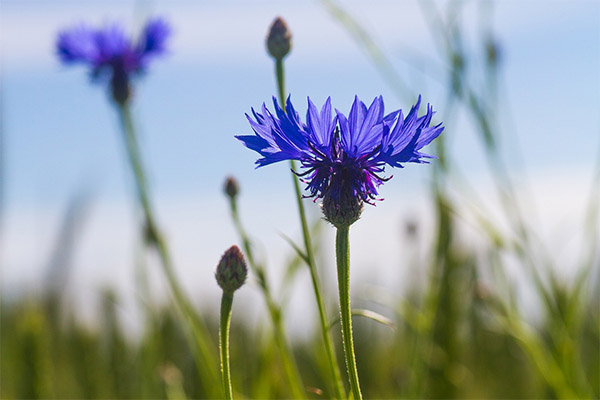
- Special substances - coumarins - in the body interact with prothrombin, so blood clotting is depressed. Cornflower should not be taken in any form with active bleeding. This applies even to wounds and cuts, you must first stop the blood, and only then, after 2-3 hours, you can apply medicated compresses.
- During pregnancy and lactation, it is not recommended to take any preparations that include field cornflower. It has a specific toxicity to the fetus and children under two years of age. The danger of systematic or single peak intake of the plant's active substances to the fetus or child with the mother's milk has been proven.
- Cornflower glycosides and essential oils are quite active and can react with many drugs. Therefore, for a period of drug therapy is better to interrupt the reception of decoctions or infusions.
- Patients with diagnosed gallstones should refrain from taking cornflower. Moderate choleretic property can lead to blockage of the duct and the need for urgent surgery.
- The peak course of systematic taking cornflower is 30 days. Then a pause of 2 weeks is necessary. Otherwise, side effects, nausea, and liver disorders are possible.
«Important: All information on this site is provided for informational purposes only. purposes. Consult a specialist before applying any recommendations. specialist before using any of the recommendations. Neither the editors nor the authors shall be liable for any possible harm caused by materials."

